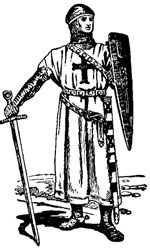
Two of the three earliest medieval romances were Troy stories: the massive Roman de Troie by Benoit de Ste. Maure and the anonymous Eneas, a retelling of the Latin Aeneid with an added happy ending. These two 12th century Troy romances were narrated in Anglo-Norman, the vernacular language of the rulers of France and Britain, who traced their history back to Brutus, descendant of Aeneas. Passion, war, exotic places and politics were always at the heart of the Trojan story, and these medieval retellings followed in that tradition. History was an important factor in the renewed popularity of Troy, which medieval Europeans considered a real place, from which real people had fled to found the Roman Empire. It is possible that the crusades also contributed to interest in Troy, since crusaders were traveling into the Near East and visiting cities such as Constantinople, only a few miles from the ancient site of Troy. Certainly, there are many description of eastern "wonders" in both the Troie and the Eneas. The retelling of the Eneas made one radical departure from the ancient Troy tradition of lawless passion leading to war. The author of the Eneas added a final section onto the Aeneid, in which love, leading to marriage, finally became a positive force for good. Love was actually rather new to the Troy tradition, and part of the literary celebration of love, courtly and otherwise, that became a hallmark of medieval literature. If you are a student in Myths and Stories of the Trojan War, the links in the yellow bar go to course-related sites. Visitors are welcome, except to the forum, which is only for students currently registered in Myths and Stories of the Trojan War.
| |||
BACKGROUND INFORMATION
- Andreas Capellanus: The Art of Courtly Love. Scroll down to see the list of Rules of Love.
- Medieval Cosmology: Includes a great diagram of the universe at that time.
- New Troy: Fantasies of Empire in the Late Middle Ages by Sylvia Federico. This book explains how Troy became an important element in British historiography of the 14th century.
ETEXTS
- Amores [Ovid]: Translated by Christopher Marlowe; a major text in the ancient tradition of the passion of love.
- "Benoit de Sainte-Maure's Roman de Troie: Historiography, Forgery, and Fiction." By David Rollo. Comparative Literature Studies Vol. 32, No. 2 (1995), pp. 191-225. It is on the J-Stor database, which can be accessed through member libraries.
- "The literature of Antiquity: Troy, King Alisaunder, Richard Cœur de Lion." From The Cambridge History of English and American Literature in 18 Volumes (1907–21). Volume I. From the Beginnings to the Cycles of Romance. Metrical Romances, 1200–1500.
- Love Destroys Achillès in Benoit de Sainte Maure's Roman de Troie: A synopsis of how Achilles is destroyed by love in the twelfth century Roman de Troie by Benoit de Ste. Maure.
- Love Redeems Eneas: A synopsis of the new love story added to the end of the Aeneid in the twelfth century Eneas romance.
- TROY BOOK: INTRODUCTION; Edited by Robert R. Edwards Originally Published in John Lydgate Troy Book: Selections Kalamazoo, Michigan: Medieval Institute Publications, 1998; this links to the entire etext of Lydgate's Troybook.
MEDIEVAL ARTS, FILMS AND MUSIC
- Medieval Music and Arts Foundation: areas include: Early Music FAQ; World Traditional Music; T. M. Mc Comb's Music Column; and So you liked CHANT...
MEDIEVAL SEARCH ENGINE
- Feminae: Medieval Women and Gender Index: This site indexes by subjects, topic, journals and essays.
METASITES
- Medieval and Renaissance Fact and Fiction: A mixture of scholarly sites and sites of interest to people who recreate the Middle Ages and Renaissance, such as the Society for Creative Anachronism. A good selection of Art sites. Fun to explore; some links will be more reliable than others, from a scholarly point of view. Worth visiting to see what pleasure people can take in studying and recreating the past.
- Netserf: A delightful site. Clear, easy to use, all sorts of links, organized with attractive images to guide the casual browser or the serious scholar. Includes everything from Franciscan clip art to serious articles about matters medieval. Maintained by the Catholic University of America History Department. Definitely worth a visit.
